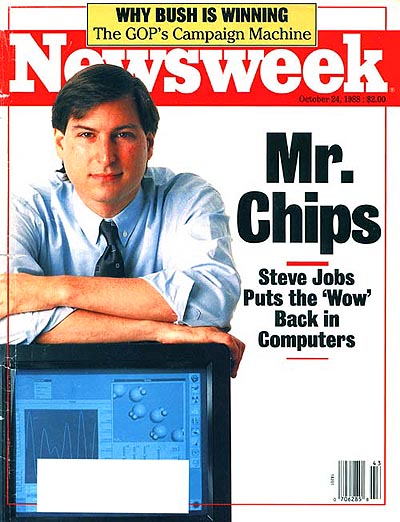Bij Ars Technica las ik dat The Fly on the Mac een twaalf jaar oud Newsweek artikel heeft gepost over de introductie van de NeXT Cube, het langverwachte eerste produkt van het bedrijf dat Steve Jobs was begonnen nadat hij halverwege de jaren '80 bij Apple was weggekickt. De NeXT Cube beschikte over destijds revolutionaire specificaties: een 25MHz Motorola 68030 processor, 8MB geheugen, 17" monochroom 4-kleuren scherm met een resolutie van 1120*832px en een 16-bit audio met 44,1KHz sampling rate. Dit alles draaide op NextStep, een op Unix gebaseerd operating system met een voor die tijd erg moderne GUI.
Inmiddels lijkt de geschiedenis zich te herhalen: Steve is terug bij Apple, Apple introduceert een PowerMac Cube, MacOS X is deels gebaseerd op NextStep en als bijkomende toevalligheid heeft opnieuw ene George Bush zich verkiesbaar gesteld voor het Amerikaanse presidentschap. Ondanks het feit dat de NeXT computers commercieel gezien weinig succesvol waren, hebben zij nog steeds invloed op de hedendaagse ontwikkelingen:
Steve Jobs was back last week with a slick new computer and more self-dramatization than ever. It's been more than a decade since Jobs, in his early 20s, co founded the Apple Computer Corp. and brought computing to the masses with the Apple Il. It's been four years since he turned the industry on to user-friendly displays and software with the Macintosh. Now, at 33, he's billing the NeXT as a computer that will revolutionize the higher-education market and point the industry toward the 1990s (next story). Love him or hate him, people in the computer world couldn't wait to see what Jobs had secretly worked on for three years in his Palo Alto headquarters. When a NeXT marketer called The Wall Street Journal to buy an ad for the rollout. the salesman quipped, "Why bother?"
Jobs has much more at stake than the $12 million he has invested in NeXT. He's rebuilding his reputation, too. Critics say Jobs' success at Apple was an accident. and that he is little more than a showman with a knack for packaging other people's engineering. Jobs is still smarting over his 1985 showdown with John Sculley, the CEO he recruited to Apple-and who ousted him in a power struggle. The public has tended to view Jobs as a techno-punk, immensely talented and charming but a tad arrogant. Learning from his defeat and re-emerging with a mature new style and machine would show the world that Steve Jobs is a serious computer maker, can run a company--and has finally grown up.
Judging from the initial reaction, Jobs has succeeded in producing what may be the most exciting computer in years. At the San Francisco rollout, the black cube wowed a by-invitation-only crowd of 3,000 executives, analysts, educators and reporters. To show off the computer's memory and speed, Jobs had it retrieve a line from Shakespeare (whose complete works come with the machines. To display its sound quality, he laid on a duet with a real violinist. When the show was over, the audience gave Jobs and his machine a standing ovation. Perhaps most impressive was the price tag--$6,500 (with a university discounts for a system that would cost more than $20,000 to reproduce with other parts. In one morning Steve Jobs breathed a sense of fun back into an industry that has become increasingly mired in marketing wars and legal squabbles. Some analysts were almost talking Jobs speak ("Wow!" "Cool!" "Insanely great!"). Esther Dyson, publisher of the industry newsletter Release 1.0, said: "It's a neat, neat box."
 |
Het artikel staat verder vol met leuke quotes over Steve Jobs, Bill Gates, Scott McNealy en andere Silicon Valley pioniers.

:strip_exif()/i/1037278465.gif?f=fpa)
